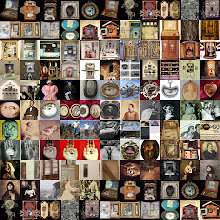Charlie Murphy's Anatomy of Desire and Other Experiments
Now you can find these cast glass sculptures made from body parts, that play with positive and negative spaces and their interaction. In other words, they explore gender and space in relation to our bodies, focusing mostly on the sexual organs. So we might find a positive, solid delineated object that represents the interior empty space inside our female selves (above) or a void in a transparent block of an erect penis (below).
Which reminds me of the film I watched last night, The Kids Are Allright and Julian Moore's character remark, when trying to explain how she and her partner, a lesbian married couple, liked to watch male gay porn... She said that, because female sexual arousal is mostly internal, it was sometimes nice to watch the overtly external male desire, or a desire that is so visually externalised.
What is interesting to me is that, following a mode of representation that is in direct contact with the real, and therefor by it's intrinsic dynamic can be legitimised as 'objective' and 'close to reality', we obtain objects that are perhaps less charged of cultural ideas in their formation, although we project them when we read them.
Murphy's approach of turning the void material and the external internal, makes use of this 'realism' of the mould, it brings our gaze to think of the surface and the form fliping, denuding our preconceived ideas of objects and space.
We are not used to thinking the shape of a uterus, the form beyond the lips is perceived like undefined cavity. As a society, we have greater familiarity and knowledge of the penis, our representation and idea of it is clear, delineated, obvious, common sense.
Sadly, the outward nature of the male organ seems to serve as foundation and legitimisation of many hierarchical values and ideas adhered to our erogenous parts, and by extension bodies, and by etension identities. I do not think gender unbalance is only based on the external/internal aspect of sexual anatomy, I do think the way we perceive our organs both informs and is informed by a larger metasctructure (paradigm, representation of reality), of which gender unbalance is part.

To illustrate my point, below an image from Vesalius' anatomical drawings, from the 16th century. Widely known as the 'father' of modern anatomy, he represented the female organs in this way, please note that both drawings are of female reproductive organs, this is a studio based on observation from dissection. Cutting open, and looking inside was not enough to give the vagina it's own shape. Most defenetively, the dissection methods used where rudimentary, and anatomists often didn't have healthy female specimens in good state, little time, accurate methods and tools to get a good picture of internal structures, from a raw, fluid, rotting, bloody mesh of fat, tissues and organs (nothing to do with the clear, simple, constructed anatomical drawings). Deciphering how things looked and which was what, was heavily influenced by medical experience and books.
Making sure he gave the vaginal entrance it's own particular shape, width, and angle, wasn't his priority either. The theory at the time was that the vagina was an inside out version of the penis. Shaped to fit the male member, and host the offspring of the patriarch.




